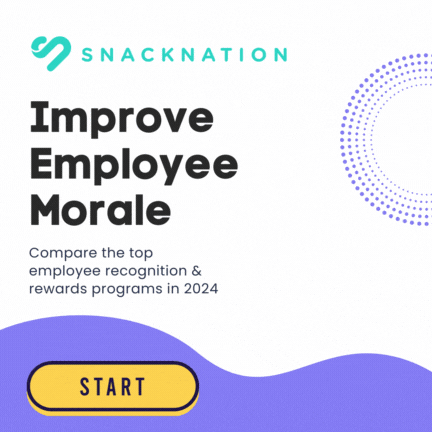Improving workplace culture is a thorny issue for most business leaders.
It’s something that they probably know is important, but can’t quite get a handle on. Finance, strategy, product development, operations – those are the tangible, measurable elements of their business.
But Culture? That’s the definition of the “soft stuff,” the stuff they probably skimmed over in business school, the stuff that makes their eyes glaze over whenever speakers bring it up at conferences.
However, more and more leaders are learning it’s no coincidence that the biggest, best, and most innovative companies also happen to have great cultures. In fact, so often these companies are great precisely because they have phenomenal workplace cultures.
Here’s why:
More than
90%
Said that culture was important at their firms
92%
Said they have believed improving their firm’s corporate culture would improve the value of the company
More than
50%
said corporate culture influences productivity, creativity, profitability, firm value and growth rates
Only
15%
said their firm’s corporate culture was where it needed to be
Peers and
camaraderie are the
#1 Reason
why employees go
the extra mile (not money)
Cost of Disengaged Workers
37%
higher absenteeism
49%
more workplace accidents
60%
more errors and defects
Companies with low employee engagement scores experience
18%
lower productivity
16%
lower profitability
37%
lower job growth
65%
lower share price over time
Businesses with highly engaged employees received
100% more
job applications
Workplace stress leads to an increase of almost
50% in voluntary turnover
$500 billion
siphoned off from the US
economy because of
workplace stress
The cost of replacing
a single employee
- http://www.forbes.com/sites/susanadams/2015/11/12/corporate-culture-matters-says-new-study/#1438cdd0d806
- https://www.greatplacetowork.com/blog/325-peer-recognition-culture-and-going-the-extra-mile
- http://bmcpublichealth.biomedcentral.com/articles/10.1186/1471-2458-11-642
- http://www.apa.org/news/press/releases/stress/2014/stress-report.pdf
- https://hbr.org/2015/12/proof-that-positive-work-cultures-are-more-productive
- http://www.gallup.com/services/178514/state-american-workplace.aspx
- https://smith.queensu.ca/magazine/issues/winter-2014
- https://www.americanprogress.org/issues/labor/report/2012/11/16/44464/there-are-significant-business-costs-to-replacing-employees/
Share this Infographic On Your Site
While most business leaders probably know a good company culture when they see one, defining what it means to have a good culture is a bigger challenge. Actually developing a strategy for creating one is a different story altogether.
Culture isn’t a one-size fits all solution. Workplace cultures take many forms, and can mean different things to different organizations. They also evolve over time as businesses change or as they grow.
That being said, company culture certainly doesn’t happen by accident. Culture is a deliberate practice, and there are clear, actionable steps you can take to guide the direction of your company’s culture in a way that benefits your employees, customers, and shareholders.
In fact, that’s what inspired us to put together this ultimate guide — you can (and should!) influence your company’s culture to fit the needs of your business. And we’re here to help you do it.
Luckily for you, we’ve already done most of the legwork for you. In the following guide, we’ve compiled the best, most actionable tips from the smartest companies with the best, most innovative cultures so you can take their learnings and apply it to your business.
Consider this is your one stop shop to learn how to improve your workplace culture and help your business go from good, to great, to awesome. Click the chapter links below to jump to your desired chapter.
Chapter 1 | How a Strong Culture Will Boost Your Bottom Line
Chapter 2 | Hire Smart and Fill the Ranks with Cultural Fits
Chapter 3 | Incorporate Wellness Initiatives to Maximize Morale and Productivity
Chapter 4 | Strong Leaders Equal Strong Cultures
Chapter 5 | Foster Loyalty & Trust Through Authentic Communication
Chapter 6 | Slash Turnover by Creating Opportunities for Growth and Development
Chapter 7 | Employee Engagement
Chapter 8 | Case Studies, Strategy Tips, and Stellar Cultures in Action
Chapter 1: How a Strong Culture Will Boost Your Bottom Line
In functional terms, your company’s culture is the sum total of the beliefs and behaviors that guide interactions between employees and other key stakeholders. It manifests in observable things like hours, dress code, benefits, workspace, turnover, hiring, and customer care and satisfaction.
But culture is also something less tangible – it’s a feeling or a vibe, the energy people bring in each day, the language they use, the mindset they adopt, and the methods they use to solve problems.
There’s a strong business case behind developing a vibrant, healthy, and productive culture, as it affects everything from the overall health and quality of life of your employees, to retention and hiring, to your company’s product, brand, and customer service – and therefore, your profits.
Here are some of the best resources for understanding culture and why it’s important.
- Workplace Culture Defined | Small Business Chron
- Why Your Company Culture Matters, and How to Improve It | The Simple Dollar
- Why Your Company Culture Can Be Your Greatest Advantage | WorkStride
- The Business Impact of a Winning Culture [infographic] | O.C. Tanner
- Company Culture: Why it Matters and How to Get it Right | Wrike
Chapter 2: Hire Smart and Fill the Ranks with Cultural Fits
The smartest companies know that developing a culture that supports their business goals starts far before their employees set foot in the office. In fact, it starts before their employees are their employees – during the hiring process.
One of the most effective ways to ensure that your culture is purposeful and strategic is to weigh cultural fit in the hiring process; the companies with the best cultures (like Zappos and Google) weigh cultural factors equally with skills, experience, and performance history. That way you’ll staff your organization with good fits from the beginning, and be more likely to increase productivity and reduce turnover.
- Cultural Fit Defined | Sheila Margolis
- How to Hire For Cultural Fit | Officevibe
- Hire for the Organization, Not Just the Job | Monster
- Building Company Culture? Start with the Interview & Hiring Process | Justworks
Chapter 3 – Incorporate Wellness Initiatives to Maximize Morale and Productivity
Studies show that wellness has a direct correlation with things like turnover, morale, and productivity, and therefore must be considered when cultivating a stellar workplace culture. The key isn’t to offer one-off perks, but to develop a holistic wellness culture that focuses on both the mind and body, and incorporates fun and a little friendly competition. Nutrition should also always be top of mind when thinking about wellness, and providing access to healthy snacks is an easy way to achieve this.
- 121 Wellness Program Ideas for Your Office | SnackNation
- Why Corporate Wellness Matters | The Huffington Post
- Six Ways to Promote Wellness at Your Organization | WorkStride
- The 5 Pieces of Employee Wellness | BenefitsPro
- Mindfulness At Work: 5 Tricks For A Healthier, Less Stressful Work Day | The Huffington Post
Chapter 4 – Strong Leaders Equal Strong Cultures
Culture starts from the top. A strong culture requires strong leadership, and leaders and managers who are accountable, transparent, and lead by example. Today’s workforce can sniff out authenticity a mile away, so it’s imperative that organizational leaders do what they say and say what they do.
- 9 Leadership Steps For Corporate Culture Change | Forbes
- Engagement Starts with Your Leaders | Wilson Learning
- How leaders can impact organizational cultures with their actions and behaviors | TalentSpace Blog
- What Bad Managers, Good Managers and Great Managers Do | Entrepreneur
- Culture-Driven Leadership | Ivey Business Journal
Chapter 5 – Foster Loyalty & Trust Through Authentic Communication
Authentic, timely, and consistent internal communication should be a cornerstone of every workplace culture. Besides the functional necessity of internal communication (i.e., employees need access to timely, relevant information to do their jobs), there’s an emotional factor as well. When transparency is high, employees feel like their bosses and their companies care about them. They feel included and “in the loop.” When transparency is low, mistrust runs rampant.
Lack of proper internal communication can make your workplace culture go from good to toxic in the blink of an eye. And like most of the elements of workplace culture, internal communication doesn’t happen by accident. It has to be programatic, and executed on a frequent and consistent basis.
- How to Become a World-Class Communicator | Awesome Office
- The Relationship Between Internal Communications and Corporate Culture | Stephen Krempl
- 6 Tips for Building a Brand Culture and Improving Internal Communications | The Financial Brand
- Creating a Basic Internal Communications Strategy | Ruth Weal
- How to write an internal communication strategy | All Things IC
- Open communication cultures: Best practice in a changing world | Melcrum
Chapter 6 – Slash Turnover by Creating Opportunities for Growth and Development
How many times have you heard this an answer to the question, why did you leave your current job?
“I wasn’t growing.”
“There wasn’t anything else to learn.”
“I felt like I was treading water.”
There’s a reason — employees need to feel like they are learning, growing, and developing in order to feel fulfilled. This is doubly true for younger workers. This year, Millennials made up the largest segment of the workforce for the first time in history, so personal growth and development better be a part of your culture if you want to retain the next generation of top performers.
- How to Create a Culture of Rapid Personal Growth | Awesome Office
- Fixed vs. Growth: The Two Basic Mindsets That Shape Our Lives | Brain Pickings
- How to Incorporate Personal Growth into the Workplace | Work Awesome
- How To: Develop a Culture of Personal Growth | Success
- 5 Ways Managers Can Encourage Staff to Do Professional Development Online | Web Courseworks
- Personal Development Goals for Work: Be Happier and Healthier | Sooniwill.be
Chapter 7 – Employee Engagement
Employee engagement is the extent to which people are personally involved in the success of a business, and it’s directly correlated with things like profitably, retention, and customer success. Although it seems like another one of those fluffy, intangible ideas, it can actually be measured – by the likelihood that an employee would recommend working at his or her company to a friend. Engaged employees work harder, are more productive, are more innovative, and are the ones you want on the front lines in moments of crisis.
Employee engagement and culture go hand in hand. Engagement will foster a positive culture, and vice versa. So exactly how do you engage your employees? We’ve got some answers:
- 29 Powerful and Proven Employee Engagement Ideas | SnackNation
- 10 Ways to Make Work More Fun and Increase Productivity | Hppy
- The 2017 Ultimate Guide to Employee Engagement | SnackNation
- Employee Engagement & Loyalty Statistics: The Ultimate Collection | Access Development
- Company Culture and Employee Engagement | New to HR
- The Guide to Modern Employee Recognition | Bonusly
- 10 Social Activities to Help Improve Employee Engagement | Herd Wisdom
- 10 Delightful Employee Reward and Recognition Ideas | JustWorks
Chapter 8 – Case Studies, Strategy Tips, and Stellar Cultures in Action
So now you know the theory. But what does it look like in practice? Here are some examples from a few of the companies who are getting workplace culture right. (Break out a pen and paper, because you may want to take some notes!)
- The Happiness Culture: Zappos Isn’t A Company — It’s a Mission | Fast Company
- Clif Bar climbs to the top of America’s workplaces | Fortune
- 4 Easy Steps to Creating the Company Culture Your Employees Crave | Insperity
- How to Create and Maintain a Workplace Culture That Will Make Your Company Thrive | Forbes
Conclusion
These resources should have you well on your way to creating an epic culture at your office. But they’re just the tip of the iceberg!
What other resources have you used to help you define your company’s culture? Let us know by leaving a comment below.
















